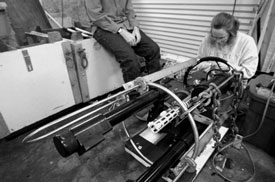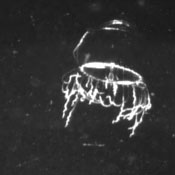 |
Daily Update
Calendar
Dispatch 29 - October 8, 2003
By C. A. Linder
Weather conditions: Overcast skies, 10 kt winds, calm seas,
air temperature 30°F
All about Bugs
Last night I awoke to the sound of my buzzing pager... That could mean only one thing - photo opportunity! I grabbed my camera gear and sturdy tripod and ventured out onto the flight deck, the best spot for viewing the night sky. At first I saw nothing, but after a few minutes the fast moving low clouds parted to reveal a bright moon. As the clouds passed over the moon, they lit up like eerie ghosts.
Today we used the CTD and Video
Plankton Recorder (VPR) to collect data at all of the WHOI mooring
locations. This is important so that we can compare this data to
what the moored instruments are recording. This year we are also
using a fancy underwater microscope called the VPR to look at the
amount and type of plankton and other particles in the water column.
Why is this important? Next year we will be able to compare these
measurements with what the mooring Acoustic Doppler Currents Profilers
(ADCPs) have recorded. Since the ADCPs measure ocean currents by
bouncing sound waves off of particles in the water column, they
can also tell us how many particles there are! Before we can do that, though,
we need to "ground-truth" the ADCP data - that's why we need
the VPR casts. They tell us exactly how much plankton is in the water column.
 |
 |
| Jeremy Kasper (left)
and Sarah Zimmermann (right) examine the VPR. |
| Click
to enlarge |
The VPR is lowered into the water using a winch, just like the CTD.
Carin Ashjian describes what happens once the VPR is brought back
on deck.
"The VPR captures images and saves them to a hard disk. Then, a computer program examines ALL of the frames (thousands and thousands) and finds things that are in focus in each frame. These in-focus portions of the image are saved to an individual file. Basically, the computer sorts out all of the in focus images from many, many out of focus blurs.
Once I have all the in-focus images, I sort
them to identify what they are. If there are a lot, I can train
the computer to do this for me! But if there aren't too many, I do
it myself. Because I know the exact time each image was collected,
I can match these times to the data on depth, temperature, and salinity.
The result is a vertical profile of the abundance of each kind of
plankton or particle at specific depths in the water and the temperature
and salinity at each depth."
Mrs. Lyons' 5th grade class at Mt. Alvernia Academy, Chestnut
Hill, Massachusetts has some great questions about arctic
plankton. Thanks to Carin Ashjian for her answers.
Question from Teddy: Is the plankton in the Arctic
different from other parts of the world?
Answer from Carin: "Yes and no. The same types
of plankton are present in the Arctic as are present in other parts
of the world. But the actual species and their adaptations to the
environment are different. Think of the different species of birds
or trees or bears. There are different kinds in the tropics than
in the continental US or in the Arctic. It's the same for plankton;
there are different species in the Arctic. However, the same basic
groups are present as are in the temperate ocean or the tropical
ocean: phytoplankton (plants) and zooplankton (animals). It's just
that the plankton in the Arctic have adapated to deal with the strongly
varying seasonal environment."
 |
 |
 |
| Carin Ashjian sorts VPR images. |
An image of a tiny medusa jellyfish imaged by the VPR. It's about the size of a pencil eraser. |
| Click
to enlarge |
Click to enlarge |
Question from Mary: If
the plankton died off and affected the food chain in the Arctic,
would it eventually affect the rest of the ocean?
Answer from Carin: "This is a tough one.
We don't really know the answer to this. First, we have to understand
how the ecosystem of the Arctic works. Then, we need to understand
how this ecocystem interacts with those in other parts of the ocean.
But we still don't understand everything about the Arctic ecosystem
and how changes there may impact the greater global environment.
It may be that the Arctic could just shut off and have little effect
on the rest of the world. But on the other hand, the Arctic might
be extremely important and a change there could have dramatic impacts.
We try to understand these things by modeling the ecosystem and
the greater global environment. And to model successfully, we need
to understand how the ecosystem works so that we can build an accurate
model. That's one reason why we're doing research in the Arctic
- to better understand the ecosystem and its role in global cycles."
Happy Birthday to Dan Torres today! I can't reveal his age, but he's really quite old.
I have really been impressed by the questions that our junior arctic
scientists at Varnum Brook Elementary School, Morse
Pond School, and Mt. Alvernia Academy
have contributed! Keep those questions "flowing!"
 Previous
Dispatch
Next Dispatch Previous
Dispatch
Next Dispatch

Back to
Calendar
|




